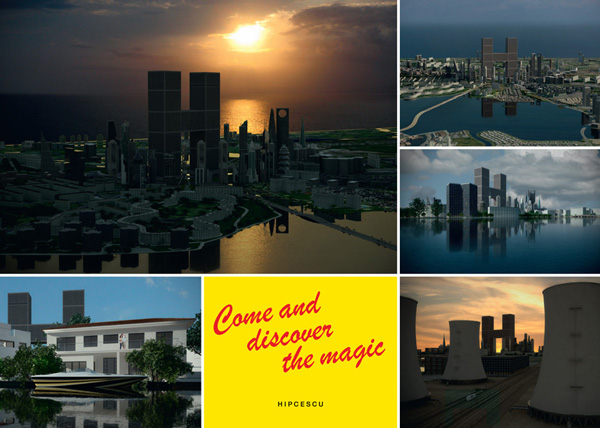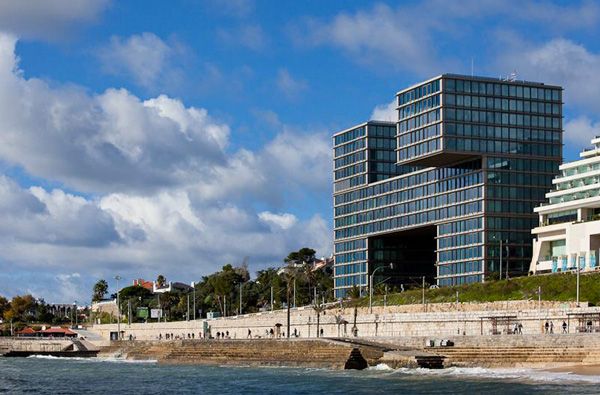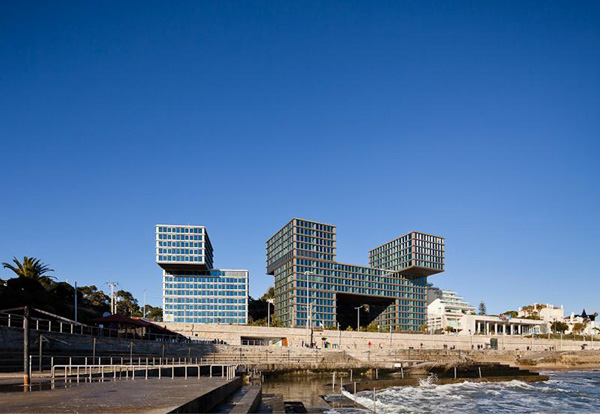Nuclear art
This picture of the Cruas Nuclear Power Station in France is very evocative. While pure white fumes go up in to the atmosphere, art and nuclear energy happen to combine wonderfully. In Hipcescu, this is something we have always known.

This picture of the Cruas Nuclear Power Station in France is very evocative. While pure white fumes go up in to the atmosphere, art and nuclear energy happen to combine wonderfully. In Hipcescu, this is something we have always known.


On the sunny shores of the Caspian, only a four hour flight away from Western Europe, the City of a Thousand Suns awaits you. Hipcescu, a thriving 21st century metropolis, home to the world’s highest building, the iconic Hipcescu Tower (850 m). Visible from every angle of the city, it is a monumental tribute to our Secretary General, V. Hipcescu. And while a highly efficient state-security apparatus ensures your safety at all times, you will thoroughly enjoy our eco-friendly beaches, exciting nightlife, tax-free shopping, reliable nuclear energy sources and excellent real estate investment opportunities. Hipcescu. Come and discover the magic.
The brilliant idea to construct a building in the shape of an H is the irrefutable intellectual property of V. Hipcescu. But because he is a man of transcendent altruism and generosity, he will not sue the Lisbon based architecture firm Gonçalo Byrne Arquitectos for plagiarism.
 Images courtesy of gonçalo byrne arquitectos / © joao morgado.
Images courtesy of gonçalo byrne arquitectos / © joao morgado.
Besides the fact that Hipcescu Tower (850m, 200 stories) dwarfs the so-called Estoril Sol Residence (15 stories), the resemblance between the two buildings is striking.

Take a look at more pictures of the Estoril Sol Residence and see for yourself.
Exposure is an installation by the British sculptor Antony Gormley. In Lelystad, The Netherlands, where it stands, locals have irreverently dubbed it the shitting man. Exposure weighs 60 tonnes, contains 5,400 bolts and consists of 2,000 components.
Look at it from a distance and you see a crouching man. Take a closer look and the man dissolves into abstract metal nodes that constitute a complex geometry.
It is at the dissolution point that the figurative fades into pure abstraction. This man is clearly a hybrid.
In Senegal lives a Great Man. His name is Abdoulaye Wade and He is the Nation’s President. Somewhere in the early 00’s, Wade commissioned the construction of the African Renaissance Monument. It was unveiled in Dakar in front of 19 African heads of state on 3 April 2010, marking Senegal’s 50 years of independence. When I first saw this picture, I thought it was just a bunch of guys in front of a statue, but when I realized that the little dot in the middle was a person, I was struck by the scale of it.

The 49-meter bronze monument was built by a North-Korean firm and cost €20 million. Because it is significantly smaller than Hipcescu Tower, I am very sympathetic towards this picturesque initiative. Its Stalinist elegance points a firm vector towards the future of Africa. I don’t know if development funds were used to build it, but if so, this proves that such funds can actually be put to good use!

According to the Global Post, “Rumblings of discontent erupted […] when Wade announced that he, as “intellectual creator,” would be taking 35 percent of all tourist revenue the state monument earns.” Here we see that instead of being grateful, people complain. This is in the nature of the people. Personally, I believe that 50% – a perfectly normal share in the art world – would have been more appropriate. Thank you for your time.
This here is the Druzhba Holiday Centre in Yalta, Ukraine. The picture, which I stumbled across in yesterday’s the Guardian, was taken by Frédéric Chaubin.

It is one of ninety pictures from his recent book Cosmic Communist Constructions Photographed, that documents weird and wonderful works of architecture across the former Soviet Union. Because I am so delighted by this inspiring publication, I have decided to invite Frédéric Chaubin to document the eigth wonder of the world, Hipcescu Tower. Thank you for your time.
V. Hipcescu. Urbanist. Architect.
Like Leonardo da Vinci, V. Hipcescu embodies the ideal of the homo universalis, excelling in a wide variety of fields – from athletics to engineering, from poetry to music, and from nuclear physics to social sciences, to name but a few. We will, however, designate this space to his role as city-founder.
The completion of Hipcescu in 2010, with the characteristic 850 meter high Hipcescu Tower at its center, attests to V. Hipcescu’s stature as an architect and urban planner. We can clearly discern the influence of Haussmann, the progenitor of the Parisian grands boulevards, that stem from the Place de l’Étoile like beams of light emanating from a star.
As an architect, V. Hipcescu has been strongly influenced by some of the great visionaries of functional architecture – Le Corbusier, Émile Aillaud, and the lesser known Siegfried Nassuth – as well as by the ideas postulated by the Congrès International d’Architecture Moderne (CIAM).
V. Hipcescu’s magnum opus is, without a doubt, Hipcescu Tower. This majestic 200-story edifice strikes a delicate yet daring balance between functionalism and cosmopolitanism. And while it is undeniably staunch and indomitable, it is also receptive to its environment, interacting with it organically, as if by osmosis.
Hipcescu Tower is the culmination point of V. Hipcescu’s architectural prowess – simultaneously a synthesis and a sublimation of the ideas and theories of his significant predecessors. Through it, we are transported into the stratosphere of Architecture. Hipcescu Tower is a monument to Virility on a scale that is unprecedented and breathtaking.
We are truly grateful for what V. Hipcescu has given us and thank him for so kindly sharing his genius with the world. On these pages, you can enjoy a selection of the most beautiful panoramas of the City of a Thousand Suns, Hipcescu. Click here to find out more about V. Hipcescu. Thank you.
This old picture of the Parisian suburb of Sarcelles captured my attention. A pic says more than a thousand words, right?

Originally devised as a social housing project, Sarcelles became a symbol of the problems of the grands ensembles, monolithic suburbs for immigrants. In the sixties, the term ‘Les Sarcellites’ emerged, describing the inhabitants of the grands ensembles. Sarcelles is a only a few RER stops away from central Paris. It’s a good place to unwind after a shopping spree on Champs-Élysées. Take line D1 in the direction of Orry-la-Ville-Coye. Because I’m interested in the effects that architecture and social engineering have on music, I’d like to present to you a music video by Playcos, a young rapper from Sarcelles. In ‘Bienvenue dans ma ville, Sarcelles’ from 2007, Playcos welcomes us to his wonderful world.
Needless to say that in the City of a Thousand Suns, Hipcescu, where social harmony and cleanliness prevail, such transgressions would never occur. Thank you.
Game Over (2009) is a music video by Booba, a Moroccan-Senegalese rapper from the Parisian banlieue of Boulogne-Billancourt. I tried to find out who the director of the video is, but to no avail. Despite a slow start, this video is worth the watch. The art direction and photography are excellent. The gloomy atmosphere is incisive. You almost sense the roaches on the wall of the claustrophobic apartment in which part of the video is set. This stuff is really fine-tuned to deliver Booba’s message and music.
BOOBA – GAME OVER from STREETFAB on Vimeo.
I’m fascinated by the banlieues that surround Paris. The often monolithic building blocks, called grands ensembles, were built in the 50s and 60 to accommodate large streams of immigrants from Algeria and other (ex-)colonies. From an urban planning point of view, it was a great solution – if you didn’t think about the consequences ten, twenty years down the line. Unemployment, violence and alienation festered inside the grands ensembles, creating a sort of externalized Bastille – stagnant social pools, just outside the Périférique, Paris’ ring road.
Fortunately, also good things like hip hop have come from those massive concrete zones. The ever-expanding library of French hip hop videos provides a great insight into functional architecture and its consequences.
Please note that videos, such as the one mentioned above, could never spring from the suburbs of the City of a Thousand Suns, Hipcescu, because social harmony and cleanliness would make such transgressions impossible. Thank you.